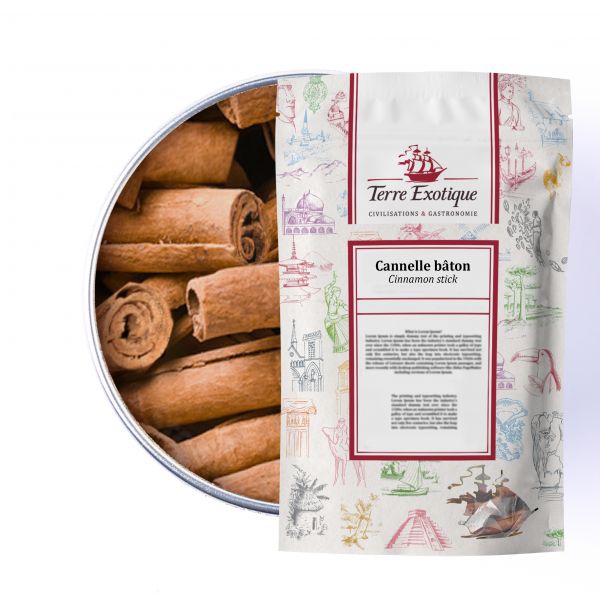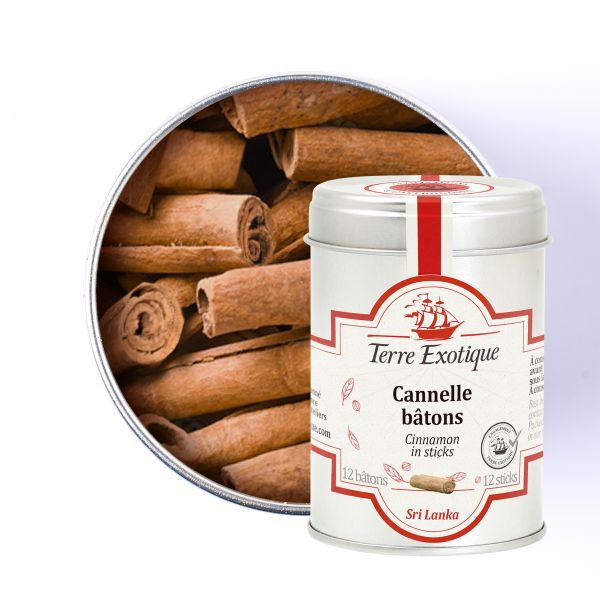







The Sweetness of Cinnamon Sticks
Cinnamon sticks emit a warm and spicy aroma, combining sweet and woody notes with a hint of spiciness. Its fragrance is comforting, reminiscent of the gentle scents of autumn and the holiday season. Cinnamon sticks add a subtle and deep aromatic dimension to a variety of sweet and savory dishes.
How to Use Cinnamon Sticks in Cooking?
In Western cuisine, cinnamon sticks are frequently used to flavor desserts such as compotes, apple pies, puddings, and hot chocolates. They are also presented as decorative elements on the plate. They can also be used for infusing in hot beverages like tea, coffee, or mulled wine, adding a touch of sweet and spicy aroma.
How to Grind Cinnamon Sticks?
To grind cinnamon sticks, you can use a spice or coffee grinder. A blender or food processor can also be used to grind them if you don't have a grinder.
What Dishes to Use Cinnamon Sticks In?
Here are some recipe ideas:
- - cinnamon rolls: use cinnamon sticks to decorate your delicious cinnamon rolls and enhance the cinnamon flavor;
- - spiced mulled wine: make your own mulled wine by simmering a bottle of red wine with cloves, star anise, orange and lemon zest, sugar, water, and four cinnamon sticks;
- - cinnamon apple compote: add cinnamon sticks during your preparation to elevate the flavor of your compote. It pairs perfectly with the sweetness of apples;
- - cinnamon coffee: add cinnamon sticks to your coffee and let them infuse. Incorporate maple syrup and top with whipped cream;
- - baked cinnamon apples: in a baking dish, arrange your apple wedges with cinnamon sticks. Add butter and a glass of water, then bake for 30 minutes.
Cinnamon, from Tree to Spice
Cinnamon is a spice obtained from the inner bark of the cinnamon tree, an evergreen tree belonging to the Lauraceae family. Its botanical name is Cinnamomum verum, also known as Cinnamomum zeylanicum. Native to Sri Lanka, cinnamon is also cultivated in other tropical regions of Southeast Asia, India, and Madagascar.
The cinnamon tree can grow up to 15 meters in height. Its oval, leathery, dark green leaves are arranged alternately on the branches. The cinnamon tree's flowers are small and greenish, grouped in clusters.
However, it is the inner bark and outer bark of the cinnamon tree that are harvested to produce cinnamon. The inner bark is harvested by hand, dried, and then transformed into cinnamon sticks or ground into powder, while the less sweet outer bark is often used to produce cinnamon essential oil.
How Do You Get Cinnamon Sticks?
The "cinnamon stick" is formed when the bark dries, first in the shade and then in the sun. It can be used whole or ground for easier use. In Europe and America, it is mainly used in baking, but in India or North Africa, it flavors savory dishes.
Cinnamon contains coumarin, which, in high doses, can be harmful to health. The tolerable daily dose should be less than 4.8 mg per day for a 60 kg adult.
The Mysteries of Cinnamon
Cinnamon is native to Ceylon, but in antiquity, its origin gave rise to many legends. The Egyptians, who used it for embalming, believed it grew according to secret rituals in a mysterious and distant land.
Thus, to uncover this mystery, Queen Hatshepsut sent an expedition to this land of Punt, the "Land of the Gods," which is now Ethiopia, and opened the spice route. From the Renaissance onwards, the Portuguese, English, and Dutch waged a fierce war for the monopoly of these spices, which they spread all over the world.
| Allergen | Absence |
|---|---|
| Native country | MADAGASCAR |
| Genus and botanical species | Cinnamomum zeylanicum |
| Ingredients | cinnamon stick |
| Nutritional Info | VN Energie pour 100 g (energy for 100g) : 1000 kJ / 243 kcal VN Matière grasse (fat) : 1.2 g Dont acide gras saturés (of which saturated fat) : 0.4 g VN Glucides (carbohydrate) : 27.5 g Dont sucres (of which sugars) : 2.2 g VN Protéines (protein) : 3.9 g Vn Sel (salt) : 0.025 g |
| TRACES EVENTUELLES D'ALLERGÈNES | céleri, sésame, moutarde, fruits à coques. |
 Français
Français 


